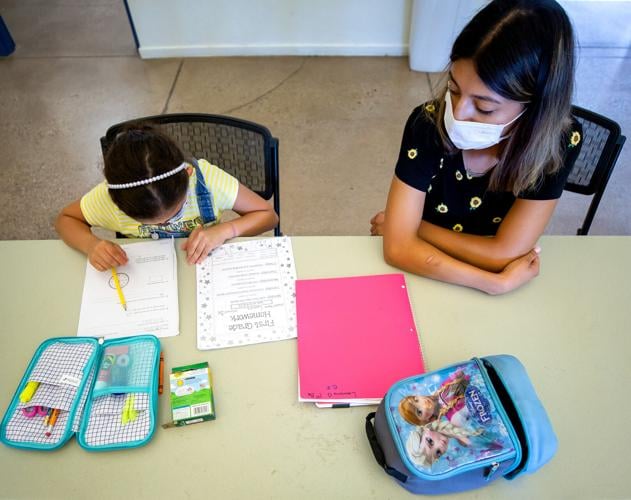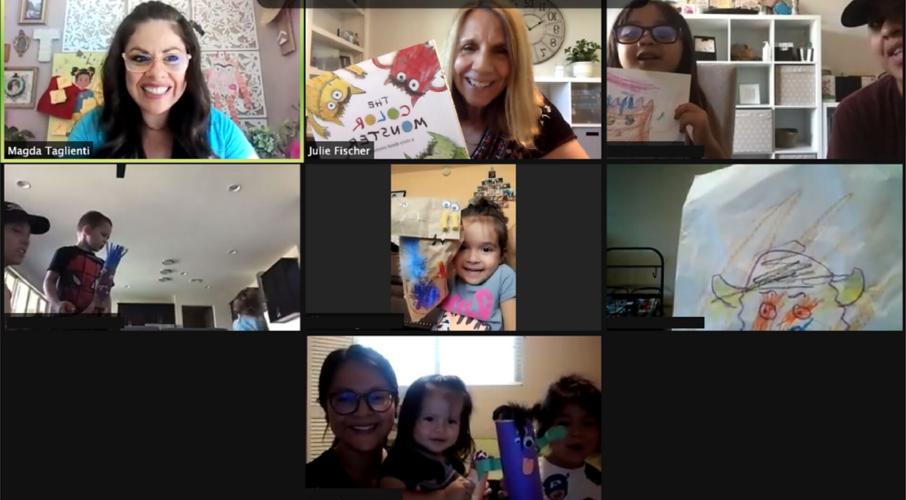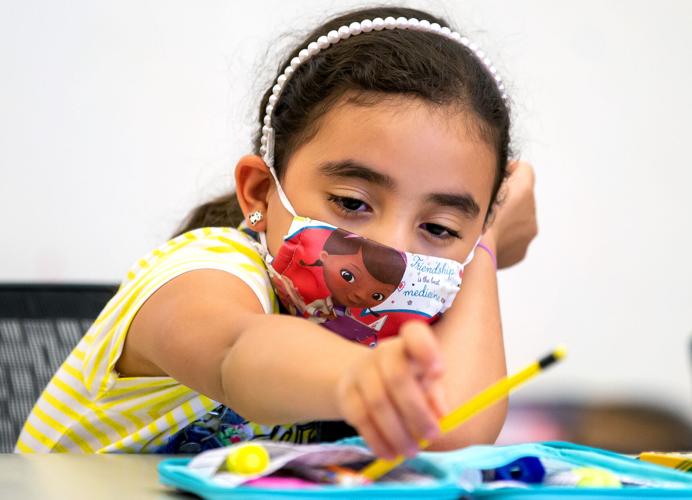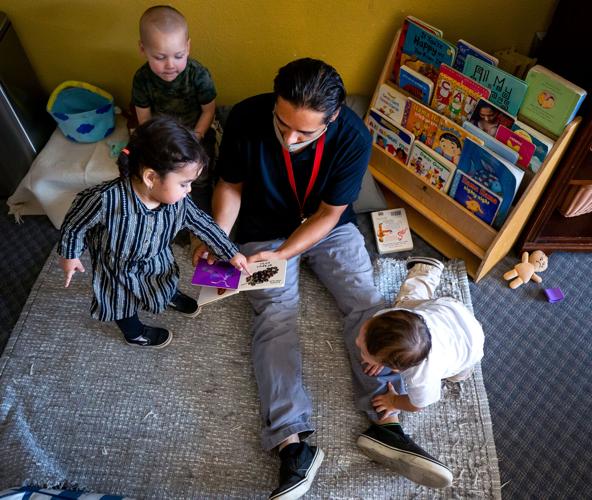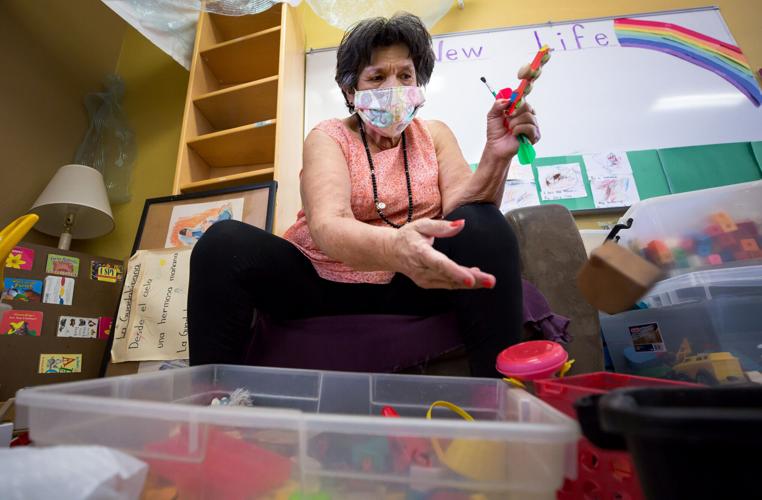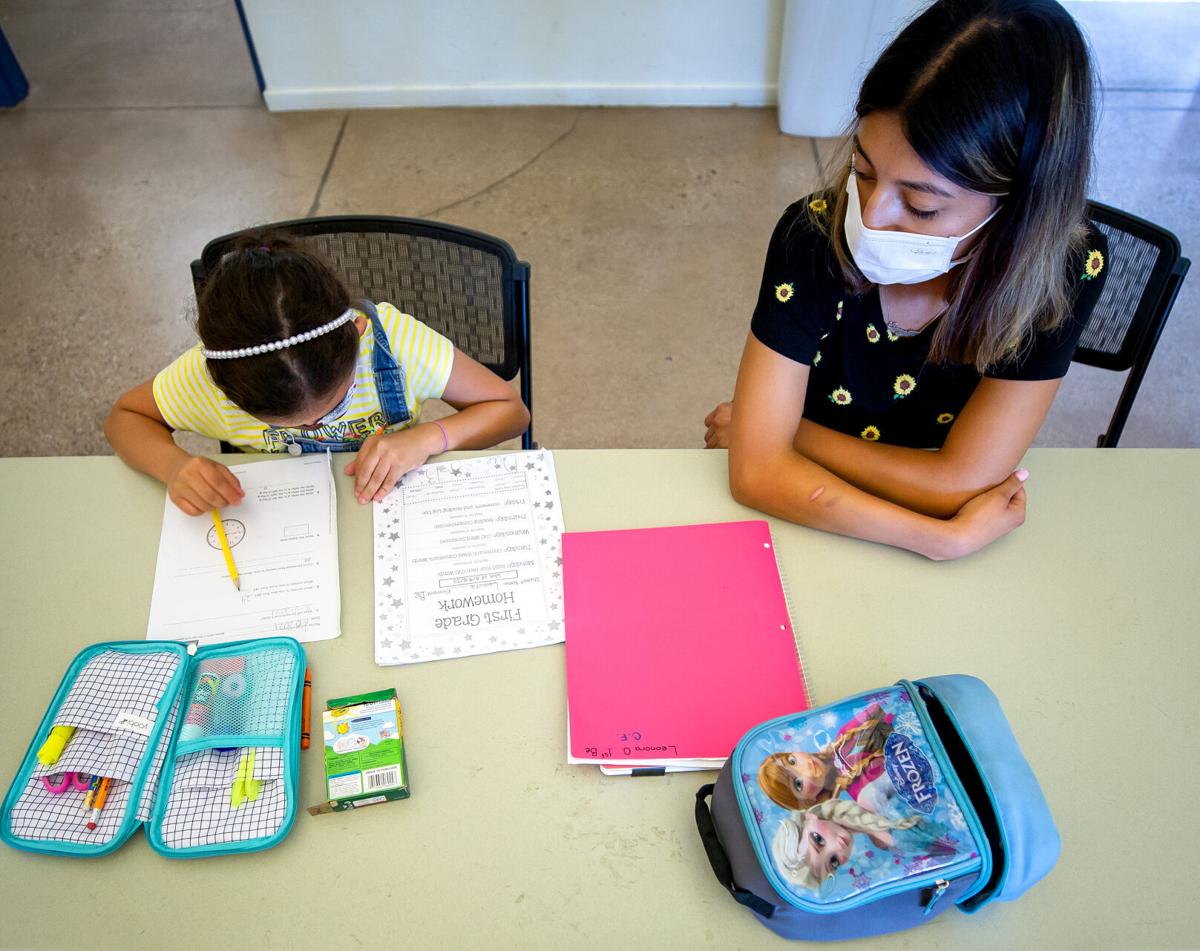This story was made possible by a grant awarded to La Estrella de Tucsón by Solutions Journalism Network, an organization dedicated to promoting journalism that analyzes community responses to specific problems.
As parents struggle to find affordable, quality child care, a number of Tucson nonprofits and organizations are stepping up, trying to help families any way they can.
Proving the old saying “it takes a village to raise a child,” some programs help directly, providing care, others offer services that allow parents and child care providers to enhance learning for babies, toddlers and school-age children.
According to the U.S. Department of Health and Human Services, child care is deemed affordable if it costs no more than 7% of a family’s income. However, for infant care specifically, which tends to be a bit pricier than caring for toddlers, only 8.7% of families in Arizona can afford an infant care program.
That means a large chunk of local families spend a higher percentage of their income on child care, impacting other expenses.
“We want to help change the system,” said Make Way For Books CEO Jenny Volpe.
Here are some ways Tucson nonprofits and businesses are providing resources for families who need it most.
When preschool isn’t an option
Make Way For Books started in 1998 and focuses on improving and enhancing the literacy skills of children.
About 80% of the families the organization serves are in poverty, Volpe said, and many are reached through community partners, word of mouth and social media recruiting.
“Achievement gaps between children in poverty and their more affluent peers become apparent by 18 months of age,” Make Way For Books says on its website. “In Tucson, 39% of children (0-5) live in poverty. For families struggling to make ends meet, early education is not obtainable.”
According to the organization, 90% of brain growth happens by the age of 5. Make Way For Books says that children who receive a high-quality education before then are 40% less likely to be held back a grade and 70% more likely to graduate high school.
Understanding that many Pima County children don’t have access to traditional preschool, Make Way For Books launched a program called Story School, which helps train parents in providing an at-home education in literacy.
“Culturally, some families would never choose preschool anyway — even if they were given a scholarship,” Volpe said of families who lean on friends or family instead of day cares or preschools. “We wanted to be a resource for those families, too.”
Story School isn’t a child care service, but is a 10-week two-generational program. It teaches literacy skills to children typically of ages 0 to 5 years old, alongside a parent who is trained on how to then hone in on those skills at home.
The deadline for Story School this year has passed, but families can apply through makewayforbooks.org/storyschool to be on the waiting list for the program’s next series in February.

Make Way For Books has a program called Story School, which helps train parents in teaching literacy skills to their children. The program switched to virtual meetings during the pandemic.
“(Story School) doesn’t replace preschool, but it has a lot of similar learning outcomes,” Volpe said. “Our kids ‘graduate’ Story School with improved literacy skills and also social skills. (Families) can’t afford preschool and they want their children to interact with a school-like environment and other kids.”
The more than 1,000 children who go through Story School — which is offered in both English and Spanish, as about 40% of families speak Spanish — receive a backpack with 20 culturally-relevant books, plus anything else they may need for additional activities. They can also stay involved with Make Way For Books until they’re 5 years old through “Story School University.”
Since moving to a virtual platform due to the COVID-19 pandemic, Story School has seen a 34% enrollment increase between the 2019-2020 year compared with 2020-2021.
Through case studies and interviews, Volpe said Make Way For Books knows 75% of the children who participate in Make Way For Books programs go on to read at or above grade level in kindergarten through third grade.
Make Way For Books also has a professional development program called The Story Project, which works with preschool teachers, as well as parents and grandparents who run child care services from their homes.
Another local program that focuses on teaching vital skills to kids is one run by the University of Arizona’s Garden Kitchen, as part of its Cooperative Extension. Prior to the pandemic, the Garden Kitchen also provided workforce development to preschool staff.

Ed Beltran, left, community outreach assistant with the University of Arizona’s Garden Kitchen, demonstrates how he pours soil and compost into a garden bed while teaching staff and teachers about gardening at Erickson Head Start child parent center, 3333 S. Mann Ave. The Garden Kitchen works with preschools to teach kids as well as teachers about gardening, nutrition and physical activity.
The program that works with early childhood centers teaches kids (and sometimes teachers and parents) gardening, nutrition and physical activity, specifically working with centers where at least 50% of the enrollees are in poverty. The program is free to the centers who want it.
“These are underserved communities,” program coordinator Glenda Garcia said. “As community outreach specialists, that’s where our focus is — closing that gap in disparities. We’d like for all of our communities to have all the information that’s available to everyone else. If they can’t get to it, then we’re gonna bring it to them.”
Eventually, the Garden Kitchen hopes to work with families who can’t afford preschool at all, similar to the methodology behind Make Way For Books’ Story School.
“We would love to be able to come into the home and help them that way,” Garcia said.
“One of the things we did see — and me personally, my wife and I used to foster some kids in the neighborhood who needed some help — we utilized a lot of child care within the neighborhood that are run out of homes,” said community outreach assistant Ed Beltran. “Those are the centers a lot of families go to because that’s what they can afford.”
In the last four years, Garcia estimates that the Garden Kitchen has worked with at least 34 early childhood centers, some of which stay on board for years. The program works with home-based preschools like Beltran mentioned, in addition to standalone centers and many preschools through Head Start.
Head Start, run through Child-Parent Centers, offers partial-day and full-time classrooms for families who qualify for the Department of Economic Security child care subsidy, and home-based services, in which pregnant women and children through age 3 are visited by a Head Start family educator once a week.
Beyond babies and toddlers
About seven years ago, The Primavera Foundation created Las Abuelitas, a 12-unit affordable housing complex initially built for grandparents raising grandchildren.
Las Abuelitas is home to a community center that houses a very small after-school program for kids between the ages of 5 and 14 years old. After-school program coordinator Victor Rodriguez promotes the school to families living in Las Abuelitas, plus other neighbors and schools in the South Tucson area.
“Our hardest part was: Where is the cutoff?” said community engagement coordinator Alonzo Morado, referring to the ages of the children the program accepts.
They decided to follow similar guidelines as Tucson Unified School District, accepting kindergarteners through 14-year-olds, citing a nearby center for teens.
For families who have kids under 5 years old, Rodriguez provides parents with resources for other day cares in the community and services that provide financial aid.
The best part about the program, though: It’s completely free for the families.
“We started it for free and we’ve kept it for free,” Morado said.
For the first five years, missionaries ran the program. Eventually, the program began collecting books, receiving small grants, and then Rodriguez hopped on board.
The program accepts children on a first-come, first-served basis. This year, 35 kids are enrolled.
The after-school program has homework and reading time, plus activities such as gardening and crafts. Rodriguez said he’s seen anecdotal evidence of academic improvement in the kids and this year, he hopes to work with parents to review kids’ grades in school to track their progress.
The program also often works with the University of Arizona College of Public Health, in which students visit each semester and work with the kids on homework, reading and health lessons such as hygiene and caring for the environment.
During the program’s existence, other special visitors have included the UA women’s basketball team, the Tucson Roadrunners and local firefighters.

Leonora Oquendo, 6, places her pencil in her bag after finishing her homework during the after-school program at Las Abuelitas, 440 E. 26th St.
“We’ve had different people come talk to them because we want to expose them to the wide world,” Morado said. “Last week, we went to the University of Arizona and it was their first time seeing a college. It was really amazing to see their faces light up — for them to see there was more for them than just high school and then work.”
“One of the biggest things is we want to make sure the families are served and the kids are in a safe space and that they’re progressing through school,” Morado said. “Our mantra is, ‘pathways out of poverty,’ and we know the best way out of poverty is through a good education and that’s why we do the after-school program. That’s why it’s important for us to expose (the kids) to the UA because a lot of times, kids in low-income areas don’t know that can be a part of their world.”
Another after-school program in Tucson is the city-run KIDCO, which costs $500 for city residents per school year and serves up to around 900 kids in kindergarten through fifth grade. Currently, around 700 kids are enrolled.
Payment plans are available for KIDCO, as are 50% discounts for low-income families. Families have to apply for the discount prior to registering for the program. Though there is no waiting list for the discount, there could be a waiting list for specific sites.
A preschool built on poverty
Ernestina Fuentes knows the plight of poor children because she was one. So when she decided to create a preschool, it was important that she not only serve those families, but that the families see themselves reflected in the staff.
“Many of the people on the board and people who stay with us and work with us have been these children here,” she said. “We come from this neighborhood here. I graduated from Sunnyside. I grew up in this neighborhood. My mom was an immigrant. We were in poverty. But then I was able to go to Harvard because I had the values and support of the community.”
“I wanted to come back and support other people. These children can do the same and there were other people who felt the same (as I did),” she said. “My research was that (early childhood education) needs to be different. What’s happening now will never get them out of poverty.”
Herencia Guadalupana Lab Schools, located at 6740 S. Santa Clara Ave., near Valencia Road and 12th Avenue, provides a high level of cognitive learning for children who otherwise wouldn’t be exposed to it, Fuentes said.
“Year after year, thousands of children are lost to the culture of poverty,” Fuentes said. “We can turn them around to be powerful, contributing people who build our world. We want to help this happen to every child we touch.”

Teaching assistant Martin Alvarez helps 1- and 2-year-olds read a picture book at Herencia Guadalupana Lab School, 6740 S. Santa Clara Ave.
“Poverty is way beyond (a number),” Fuentes added. “There’s an attitude, there’s a cultural perspective. We have families who have four generations of poverty who have lost their spirit. That’s what we’re combating.”
Guadalupana has built a model in how staff talks and interacts with children. The model nurtures the values of resilience, perseverance, goal-focus and self-regulation, Fuentes said.
For example, if a child needs help opening a package of crackers, Guadalupana staff won’t open it for them. Instead, they’ll ask questions — such as “do you think you can open it with a pair of scissors?” — that spark kids’ interest in opening it themselves.
Fuentes said it may seem counterintuitive, but Guadalupana staff want to make sure children are making their own decisions.
“We have incredibly strong children,” Fuentes said.
Another piece in the puzzle is that some children that Guadalupana serves have experienced trauma.
“The first thing you do is (ask), ‘What do they need?’ … and provide it,” Fuentes said. “You analyze. You don’t react. You support and create a situation for them to be secure and happy and strong.”
Most of the evidence of children’s growth after leaving Guadalupana is anecdotal.
Fuentes said she knows of at least 20 children who after leaving Guadalupana, either skipped kindergarten and went straight to first grade or were able to enter a mixed kindergarten-first grade class.
“One charming little boy went into kindergarten and I said, ‘How’s kindergarten?’ and he goes, ‘I was too smart. They put me in first grade,’” Fuentes recalled.
Fuentes estimates that 80% of Guadalupana families are bilingual in English and Spanish, with some families only being Spanish speakers. Out of 16 staff members, 14 are bilingual.
For children who are monolingual in Spanish or need more language support, staff will teach instructional lessons in Spanish, but pivot to teaching enrichment activities — such as plays and music — in English.
Currently, the majority of children that Guadalupana serves are those in foster care, with the expense fully covered by DES.
For those without a state subsidy, the average cost per month at Guadalupana is $600 for a child ages 3 to 5 years old — less than the average cost of child care for a 4-year-old in Arizona of $712 per month, according to the Economic Policy Institute.
Flexibility is available for families unable to afford the cost, Fuentes said.
“Dr. Fuentes worked with me financially because we were just on my husband’s income at the time,” said Regina Chavez, a parent of two children who attended Guadalupana.

Ernestina Fuentes, executive director of Herencia Guadalupana Lab School, goes through a bucket of items while reorganizing toys in 2020.
“I feel like Dr. Fuentes worked with me so much. It was never like, ‘Oh, my God, what am I going to do?’” Chavez said.
Chavez previously lived in San Diego and was a stay-at-home mom because she couldn’t afford to pay for child care. When moving to Tucson, Chavez learned about Guadalupana and enrolled her then-3-year-old daughter and later her son.
“I liked that there was a lot of one-on-one stuff to do with the kids,” she said. “My daughter benefited from it — she went into a kinder-first class, not just a kinder class. She was doing first grade stuff at a kindergarten age.”
“I felt like all the other schools were run more like a day care,” she said of her experience looking into other child care options. “And with Dr. Fuentes’ school, they want them to learn.”
Chavez said she’d love to see more scholarships offered at preschools.
“I just think you have to constantly be thinking about low-income-based families and how they’re affected and how you can help,” she said.
Junior Togafau agreed. Two of his great-grandchildren, who he adopted in 2018, attended Guadalupana thanks in part to financial aid awarded to him from the state during the adoption process.
He thinks his kids received the upper-hand because of Guadalupana.
“It prepares them for their journey through school and you get a good head start,” he said. “It’s not a crash course. You’re building their interest, you’re building their knowledge. You’re building their attitude.”
“It’s always nice to know there’s a place where you send your (kids) and you know they’re being taught skills and values and are given the opportunity to expand their horizons,” he said.
But he knows that one of the biggest problems with sending children to preschool is the cost.
“I think there should be more scholarship programs and more things to help families who can’t bear the cost of tuition,” he said.
Fuentes is researching ways to reduce the cost and where to get funding to do that, including the school’s crowdsourced scholarship fund which can be found at hgls-prek.com/ways-to-give. Currently, Guadalupana offers five scholarships with First Things First, plus four partial scholarships from Quality First.
Beyond cost, Fuentes said she believes Guadalupana has yet to reach those who need it most, such as undocumented families, parents who don’t qualify for DES by a dollar or two and families who are unaware they qualify for DES assistance at all.
“One of the reasons is people are frightened and people don’t trust,” she said, adding that stopping to evaluate a child’s preschool journey often isn’t an option when parents are “living in survival mode.” She hopes to do more outreach soon.
Guadalupana currently serves around 60 children, with space for about 20 more. Over the course of eight years, Fuentes estimates that the school has served between 800 and 900 children.
One of Fuentes’ next goals is to build an early childhood center in a prominent location on the south side. She’s hoping to serve 200 children there, plus add offices to connect families with resources such as DES.
What does this story mean to you?
Knowing how this story may have influenced you can help steer future reporting that provides value to readers.
Please let us know what you think by taking the Arizona Daily Star's survey here.


